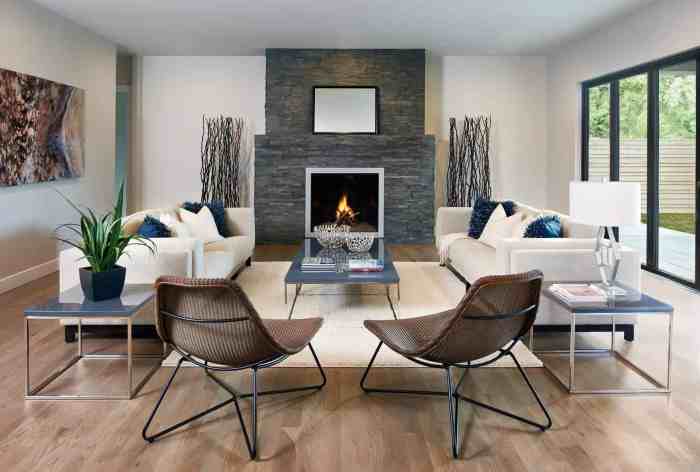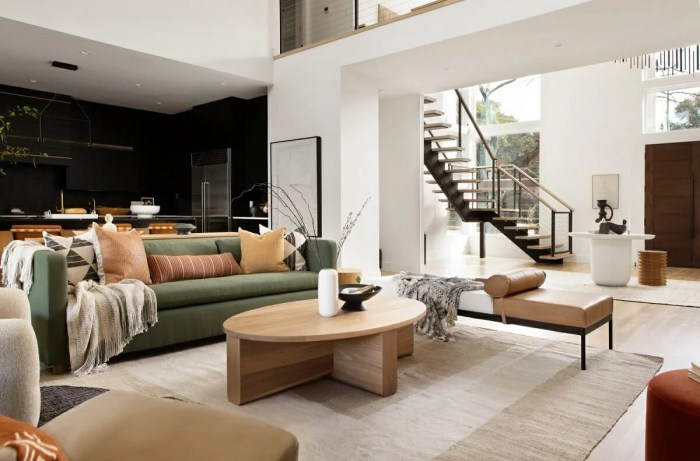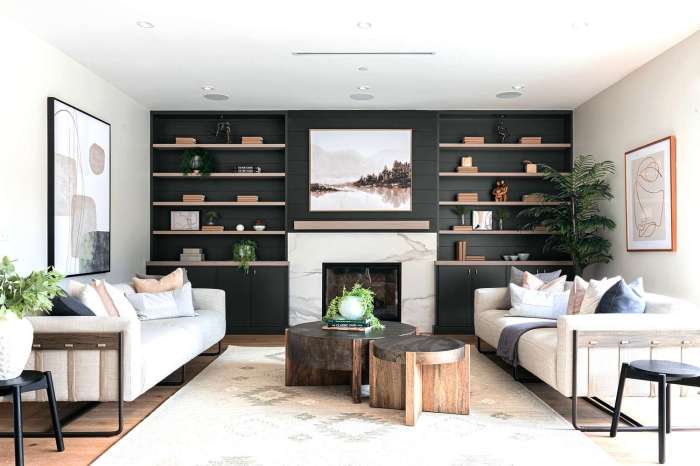Designing a modern living room balances form and function, creating a space that’s both stylish and comfortable. This guide unveils five essential tips to help you achieve the perfect blend of minimalist aesthetics and practical living. We’ll explore key design principles, space optimization techniques, and color palette choices to transform your living room into a haven of modern elegance.
From understanding the core tenets of modern design – clean lines, functionality, and minimalism – to mastering space planning and selecting the right color scheme, this guide provides a comprehensive approach. We’ll delve into creating effective layouts for various room sizes, incorporating smart storage solutions, and strategically using lighting to enhance the ambiance. Finally, we’ll examine the subtle art of incorporating decorative elements that elevate the space without compromising its clean, uncluttered feel.
Defining Modern Style in Living Room Design

Modern living room design prioritizes clean lines, functionality, and a minimalist aesthetic. It’s about creating a space that is both stylish and practical, emphasizing quality over quantity. This approach fosters a sense of calm and spaciousness, even in smaller rooms. The core principles are easily adaptable to various personal styles and preferences, allowing for unique and personalized expressions of modern design.
Modern furniture styles for the living room are characterized by their simplicity and streamlined forms. Materials are often chosen for their durability and inherent beauty, with a focus on natural or neutral tones.
Modern Furniture Styles and Materials
Modern living rooms often feature pieces with simple geometric shapes, devoid of excessive ornamentation. Sofas, for example, might have low profiles and clean lines, crafted from materials like leather, linen, or high-quality microfiber. Armchairs could be upholstered in a single, neutral-toned fabric or feature sleek metal frames. Coffee tables frequently showcase minimalist designs, often made from wood, glass, or polished metal, with simple, straight legs. The overall effect is one of understated elegance and sophisticated simplicity.
Comparison of Modern, Traditional, and Transitional Styles
Understanding the differences between modern, traditional, and transitional styles is crucial for defining your own design preferences. While modern emphasizes minimalism and functionality, traditional styles embrace ornate details and rich textures. Transitional design acts as a bridge between the two, blending elements of both. The following table highlights key distinctions:
| Style | Key Characteristics | Color Palettes | Furniture Styles | Common Materials |
|---|---|---|---|---|
| Modern | Clean lines, minimalist aesthetic, functionality, open space | Neutral tones (whites, grays, blacks), pops of bold color | Sleek sofas, low-profile furniture, simple geometric shapes | Leather, linen, wood, glass, metal |
| Traditional | Ornate details, rich textures, symmetrical layouts, classic silhouettes | Warm earth tones, deep jewel tones, rich browns | Ornate sofas, carved wood furniture, plush fabrics | Wood (mahogany, cherry), velvet, silk, heavy fabrics |
| Transitional | Blends modern and traditional elements, balanced approach | Neutral base with pops of color, mix of warm and cool tones | Clean lines with some ornate details, comfortable yet stylish | Wood, leather, linen, some metallic accents |
Optimizing Space and Layout for Functionality

Efficient space planning is paramount in modern living room design. A well-designed layout maximizes functionality while maintaining a sense of openness and style. Consider the size of your space and the activities you’ll be undertaking in the room when planning your furniture arrangement. Proper traffic flow and the creation of distinct zones are crucial for creating a comfortable and usable space.
Different living room layouts cater to various space sizes and needs. Strategic furniture placement significantly impacts the room’s overall feel and functionality.
Living Room Layouts for Different Space Sizes
The following examples demonstrate efficient furniture placement for small, medium, and large living rooms. The choice of furniture pieces should be guided by the available space and the desired functionality.
- Small Living Room (e.g., 10ft x 12ft):
- A compact sofa (loveseat or small sectional)
- A small coffee table
- A floating shelf for storage and display
- A single accent chair
- A floor lamp
- Medium Living Room (e.g., 15ft x 15ft):
- A standard-sized sofa
- A coffee table
- Two accent chairs
- A media console or entertainment center
- A floor lamp and a table lamp
- A rug to define the seating area
- Large Living Room (e.g., 20ft x 20ft):
- A large sectional sofa
- A large coffee table
- Two armchairs or a chaise lounge
- An entertainment center
- Multiple lighting sources (floor lamps, table lamps, overhead lighting)
- A separate reading nook or conversation area
Traffic Flow and Zonal Design
Maintaining a clear and efficient traffic flow is essential for a functional living room. Distinct zones should be created to delineate different activities, such as conversation, relaxation, and entertainment. Overlapping zones should be avoided to maintain a sense of order and spaciousness.
Imagine a rectangular living room. The entry point is on the long side. The sofa is positioned along the opposite wall, creating a natural focal point. Two armchairs are placed at a 90-degree angle to the sofa, forming a conversation area. A coffee table sits between the sofa and armchairs. The TV is positioned on the short wall opposite the entry, with a media console beneath. Traffic flows naturally from the entry, past the conversation area, towards the TV and back. This avoids crossing pathways and maintains a sense of ease of movement.
Built-in Storage and Multi-functional Furniture
Built-in storage solutions and multi-functional furniture are invaluable in maximizing space, particularly in smaller living rooms. Clever storage ideas help maintain a clutter-free and aesthetically pleasing environment.
- Built-in shelving units: These can be incorporated into the wall to provide ample storage space while maintaining a clean aesthetic.
- Ottoman with storage: An ottoman with a lift-top provides hidden storage for blankets, pillows, or other items.
- Coffee table with drawers or shelves: This provides convenient storage for remotes, magazines, and other essentials.
- Sofa beds: A sofa bed offers flexibility, serving as both seating and sleeping space for guests.
Selecting Color Schemes, Lighting, and Decor

Creating the perfect atmosphere in a modern living room involves a careful selection of color palettes, a well-thought-out lighting plan, and the strategic incorporation of decorative elements. These choices work in synergy to define the space’s personality and functionality, ensuring both aesthetic appeal and practical usability. The right combination can transform a room from merely functional to truly inviting and stylish.
Modern Living Room Color Palettes
A thoughtfully chosen color scheme is foundational to a modern living room’s aesthetic. Below are three distinct palettes, each offering a unique ambiance. Consider the mood you wish to evoke when making your selection.
- Warm Neutrals: This palette centers around creamy whites, beige tones, and warm grays. Accent colors could include soft browns or muted golds. This creates a feeling of calm, sophistication, and warmth, perfect for a relaxing and inviting space. Imagine a living room with off-white walls, a beige sofa, and throw pillows in various shades of brown and cream, complemented by gold-toned accent pieces.
- Cool Tones: This scheme utilizes shades of gray, blue, and green, potentially incorporating lighter pastel accents. This results in a serene, contemporary atmosphere, often associated with a sense of tranquility and spaciousness. Visualize a living room with soft gray walls, a light blue sofa, and teal accent cushions. Silver or chrome decorative elements could further enhance the cool, modern feel.
- Bold Accents: This option features a neutral base (like a warm gray or off-white) punctuated by vibrant pops of color – perhaps deep teal, mustard yellow, or burnt orange. This approach adds energy and personality, creating a striking and memorable space. Picture a living room with gray walls, a white sofa, and accent chairs in a bold mustard yellow, with artwork featuring complementary colors.
Modern Living Room Lighting Design
Effective lighting is crucial for both functionality and atmosphere. A layered approach, incorporating ambient, task, and accent lighting, is key to creating a versatile and visually appealing space.
- Ambient Lighting: This provides overall illumination. Recessed lighting or a stylish contemporary chandelier can achieve this. Consider LED panels for energy efficiency and even light distribution.
- Task Lighting: This focuses light on specific areas, such as reading nooks or workspaces. Floor lamps with adjustable arms, table lamps with directed light, or even strategically placed wall sconces can serve this purpose.
- Accent Lighting: This highlights architectural features or artwork. Track lighting, picture lights, or strategically placed spotlights can create dramatic effects and add visual interest. Consider using dimmer switches to control the intensity and mood.
Key Decorative Elements for a Modern Living Room
Over-decoration can detract from the clean lines of a modern aesthetic. Focusing on a few carefully chosen pieces is essential.
- Statement Artwork: A large-scale piece of art can become a focal point, adding personality and visual interest. The choice of artwork should complement the chosen color palette.
- Textured Rugs: A rug adds warmth and defines the seating area. Choose a rug with a simple yet interesting texture, such as a natural fiber rug or a geometric pattern rug. The color and texture should complement the overall scheme.
- Sculptural Planters: These add a touch of nature and visual interest. Choose planters with clean lines and simple shapes that echo the overall aesthetic. Consider using succulents or other low-maintenance plants.
- Metallic Accents: Subtle metallic elements, such as a chrome coffee table or brass side lamps, can add a touch of luxury and sophistication. Choose metals that complement the color scheme – gold for warm palettes, silver or chrome for cool palettes.
- Minimalist Throw Pillows and Blankets: These add comfort and texture without cluttering the space. Choose a few high-quality pieces in colors and textures that complement the overall scheme. Avoid excessive patterns or busy designs.
Last Point

Creating a modern living room is a journey of thoughtful design choices, culminating in a space that reflects your personal style and prioritizes both aesthetics and functionality. By understanding the principles of minimalism, optimizing space through clever layouts and storage solutions, and carefully selecting color palettes and lighting, you can transform your living room into a sophisticated and inviting sanctuary. Remember that the key lies in balance – a harmonious blend of form and function that creates a space as beautiful as it is practical.